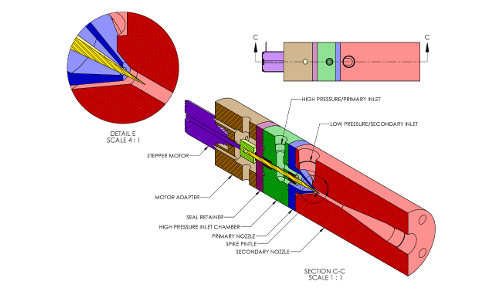Standard Ejectors
Sonijector offers a wide range of standard ejector designs, available with short lead times.
-
15kW Class
For small fuel cell systems such as forklifts, utility vehicles, light transit vehicles in city service, and residential backup power.
The first ejector we built has been in service in the University of Delaware's Phase 1 fuel cell bus since 2010. It replaced a stainless steel and graphite vane pump that experienced frequent seizing and corrosion of the bearings. With all its wetted parts made of anodized aluminum, it has effectively resisted the corrosive effects of wet hydrogen.
-
30kW Class
For systems with higher demand—load-following cars and vans in city service, light transit vehicles in suburban service, and small/medium business backup power.
This class was introduced for the University of Delaware's Phase 2 fuel cell bus, building on the success of the 15kW model. It introduced an improved coupling between the stepper motor and the needle, and a simplified control algorithm that reduced startup time.
-
45kW Class
For load-following powersports vehicles, full-sized transit buses, and more.
This design was simply a scale-up of the 30kW class. It was introduced along with our latest electronic control module, which brought reduced cost and weight and the capability for underhood installation. It was first installed in the University of Delaware's Phase 3 fuel cell bus.
-
100kW Class
Our highest-capacity standard design. For load-following passenger cars operated on the highway, heavy duty over-the-road vehicles, and multifamily/data center backup power.
The larger channels in this model allow it to develop increased pressure rise compared to the smaller models, or operate despite high inert gas loadings.








